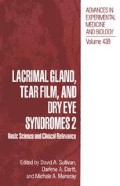Abstract
Androgens are known to control the development, differentiation and lipid production of sebaceous glands throughout the body.1 Given that the meibomian gland is a large sebaceous gland,1,2 we hypothesize that androgens may regulate meibomian gland function, enhance the quality and quantity of lipids produced by this tissue and stimulate the formation of the tear film’s lipid layer. In addition, we hypothesize that androgen deficiency (e.g. due to menopause, aging, Sjögren’s syndrome, anti-androgen medications, inherent insensitivity) may lead to meibomian gland dysfunction and consequent ‘evaporative’ dry eye.
Access this chapter
Tax calculation will be finalised at checkout
Purchases are for personal use only
Preview
Unable to display preview. Download preview PDF.
References
Thody AJ, Shuster S. Control and function of sebaceous glands. Physiol Rev 1989; 69: 383–416.
Driver PJ, Lemp MA. Meibomian gland dysfunction. Sury Ophthalmol 1996; 40: 343–367.
Luu-The V, Sugimoto Y, Puy L, Labrie Y, Solache IL, Singh M, Labrie F. Characterization, expression, and immunohistochemical localization of 5a-reductase in human skin. J Invest Dermatol 1994; 102: 221–226.
Sullivan DA, Kremer KL, Ullman MD, Wickham LA, Toda I, Bazzinotti D, Dana MR. Androgen control of the meibomian gland. Submitted for publication, 1997.
Lemp MA. Report of the National Eye Institute/Industry Workshop on clinical trials in dry eyes. CLAO J 1995; 21: 221–232.
Bron AJ, Benjamin L, Snibson GR. Meibomian gland disease. Classification and grading of lid changes. Eye 1991; 5: 395–411.
Wickham LA, Gao J, Toda I, Rocha EM, Sullivan DA. Identification of androgen, estrogen and progesterone receptor mRNAs in rat, rabbit and human ocular tissues. Submitted for publication, 1997.
Rocha EM, Wickham LA, Silveria LA, Krenzer KL, Toda I, Sullivan DA. Identification of androgen receptor protein and 5a-reductase mRNA in human ocular tissues. Submitted for publication, 1997.
Chomczynski P, Sacchi N. Single-step method of RNA isolation by acid guanidinium thiocyanate-phenolchloroform extraction. Anal. Biochem. 1987; 162: 156–159.
Author information
Authors and Affiliations
Editor information
Editors and Affiliations
Rights and permissions
Copyright information
© 1998 Springer Science+Business Media New York
About this chapter
Cite this chapter
Sullivan, D.A. et al. (1998). Androgen Regulation of the Meibomian Gland. In: Sullivan, D.A., Dartt, D.A., Meneray, M.A. (eds) Lacrimal Gland, Tear Film, and Dry Eye Syndromes 2. Advances in Experimental Medicine and Biology, vol 438. Springer, Boston, MA. https://doi.org/10.1007/978-1-4615-5359-5_46
Download citation
DOI: https://doi.org/10.1007/978-1-4615-5359-5_46
Publisher Name: Springer, Boston, MA
Print ISBN: 978-1-4613-7445-9
Online ISBN: 978-1-4615-5359-5
eBook Packages: Springer Book Archive

